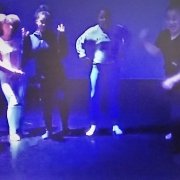Inspiration 5
Excerpt
This is an initiative to inspire school children from schools with traditionally low transition into Higher Education (HE) to choose university studies.
In Sweden, school children start year 5 in primary school at the age of 11, an age when they are old enough to take part in discussions on HE and future possible careers, but not so old that they have decided if they are someone who will (not) enter into HE. Hence the name Inspiration 5 (i5).
The general objective with the project is to make the idea of HE less dramatic and at the same time inform the participants about the range of studies within HE.
To reach these objectives, the project is based on three principles.
- Starting at an early age
If the information on HE reaches the pupils only when they are about to finish lower or upper secondary school, chances are that they have already formed an identity on being, or not being, “someone who studies”. Also, forming the idea of becoming a future university student may take time.
- Entire school classes
The project does not single out the ones already interested or the most talented. The reason for that is to give all children the opportunity to get to know the world of the university, regardless of their current thoughts on education.
- Continuity
Meeting the children throughout their school years from age 11, and not only once or twice. This is to give the children a sense of familiarity with the university.
Narrative, origins and objectives of the initiative
What kind of project is this? Please give a short description (summary) of it.
A widening participation initiative, aiming to inspire school children between the ages of 11 to 16 to HE through activities in different areas of the university. The initiative engages one new Malmö school per year, and one school permanently — 6 schools in parallel.
Please tell us why, in general, this project is considered a successful one?
If school children’s awareness of HE increases, they are more likely to plan for their future studies and seek spontaneous study counselling with their school study counselor after participation.
And why would you consider it a grass-roots initiative?
Initiative from a university staff, seeking to inspire Malmö school children not to deselect HE due to a lack of information.
What challenges needed to be solved in this project?
Most school teachers are engaged and active in the project, but at times it can be challenging to inspire the school teachers to take part, communicate and to attend the activities with the school children.
Engaging university staff is at times equally challenging, and most of the staff participating does so due to personal connections with the project management.
Is this initiative based on any particular theoretical framework? Which one?
The general notion is that 11 year-olds are old enough to understand discussions on HE and future possible careers. However, they have not decided if they are someone who will (or will not) enter into HE.
(Appendix) Is your intervention standing on its own or is it a part of a bigger and more holistic approach?
MUVAH, Malmö Ungdomars Väg till Arbete genom Högre studier (Malmö Youths’ Ways to Work through Higher Education), is a broad initiative between Malmö University and Malmö City to map the Malmoers’ ways through education for a better understanding of their career choices.
Please describe the group(s) intended as beneficiaries of this initiative
Why has this group (have these groups) been chosen?
At the age of 16, Swedish school children choose upper secondary programmes, and therefore this age group is suitable for a long term activity scheme to inspire to HE.
Many Malmö schools have a low transition rate into HE, and this needs to be addressed well before choosing—or, indeed not choosing—upper secondary school programmes.
Could you please tell us something about the relative size of the (of each) target group, within the school/university population, region and/or country?
Each year project i5 starts a working relationship with grade 5 at two schools in Malmö. The project continues with these classes until grade 9. The size of the target group changes each year but there are generally 40—70 pupils/year.
Which social characteristics are taken into account and what is the geographical area covered?
Schools in areas of Malmö with low transition into HE.
On which level is the project implemented?
In the participating schools: Principal, teachers in the involved grades and pupils. At Malmö University: Teachers, guidance counselors and students from different departments. A collaboration between the university and the city of Malmö with the focus on getting youth into the workplace through HE has shown interest in project i5 and will do research on the impact of the project.
Please describe the political and socio-economic factors that you believe have been important enablers for your initiative
Did the initiative have political support?
How did it fit with local, regional or national policies?
It fits well. The aim to even out the inequities between school children from an academic/non-academic background is an outspoken one on different political levels. The city of Malmö works for a sustainable society with equal opportunities for all inhabitants of the city.
It also fits well with the fact that “Malmö University strives to be part of society at every level. Whether that is regionally, nationally or globally, our focus is on making the world a better, fair place”.
Who are the stakeholders supporting the initiative?
Are there particular demographic changes present that are influencing the project?
What is the institutional strategy and culture of the (educational) organization?
Malmö University is a widening participation (WP) university with an articulated aim of inclusion of underrepresented groups.
To what extent does the initiative have an influence on institutional policy (or potential influence) of the (educational) organization?
The potential influence on the university is that widening participation becomes increasingly intertwined with all parts of the university and that the idea of widening participation involves the society better, starting with younger children all the way through graduating from HE.
(Appendix) Is there public support for your initiative and the issue it addresses?
Schools and the city are very positive; no survey has been carried out yet, but in meetings and informal discussions, participating and non-participating schools as well as representatives of the city give positive response to the initiative.
(Appendix) What other factors do you think have been important for the success of this initiative?
Continuity and engagement in programme management and the core group of Malmö University employees involved in the project; Institutional support and budget.
Please describe the overall initiative design and the methods and tools used to reach the goals
Please describe the specific activities carried out.
Grade 5: University visits the school with two students where we engage the pupils in discussions about HE in a relaxed way, movie clips about different educations, games with prizes involving different educations.
Grade 6: The classes visit the university a full day to participate in different workshops and quizzes.
Grade 7–9: The classes visit the university for half a day to participate in workshops e.g. competences, options for studies, human rights/children’s rights (teachers and students from different departments are involved).
Grade 9: Visit to the Department of Dentistry.
What were the key roles (teacher, student, management team etc.) within the project?
Project manager and one coordinator are the key role players and they involve students and teachers at the university for the different activities.
What ideas, tools, theories, models, methodology (etc.) have been used to reach the goals?
What are the final revenues of the project?
Please describe if your project ensured its sustainability
If so, how did you ensure the short-term impact of the project?
Making activities relevant, age appropriate and fun.
And how did you ensure the long-term impact of the project?
One school has been involved since the beginning in 2009. It can simplify research but also ensure long-term relationships with teachers at the school. This makes it easier to book activities and keep continuous contact with the school in question.
Has your project been replicated elsewhere?
Please tell us about the resources used in this initiative
What was the budget for the initiative?
10% employment of coordinator, 10% project manager. Within university teachers’ employment. Student salary: 10–40 hours/year
How much did the initiative depend on volunteers?
The project has been able to pay students who were involved. The participation in the project by teachers at the university and the schools have been part of their regular employment. The project has not used volunteers aiming at workers without salary, but the project has to depend on employees at the university to volunteer their involvement.
How were the costs perceived by the public/the sector/other stakeholders?
To what extent did the initiative achieve its objectives?
Please describe the evidence to support the success of your initiative.
The project is currently being evaluated as a whole and has therefore no statistics to present. However, the participating children, teachers and guidance counsellors all claim that the children are aware of the possibilities they have after compulsory school and show an interest in higher education to a greater extent than before taking part of the project.
Did the intervention lead to any unintended (positive) outcomes?
The students not only get questions about their education but also living arrangements, loans, missing their families etc., which is positive because hopefully the project can tear down barriers that are perhaps only noticeable by people outside HE.
What indicators (quantitative and qualitative) have you measured to demonstrate success?
Evaluations/research not complete.
(Appendix) How did you evaluate/monitor this intervention?
Monitor by notes.




 Simona Cerrato
Simona Cerrato


